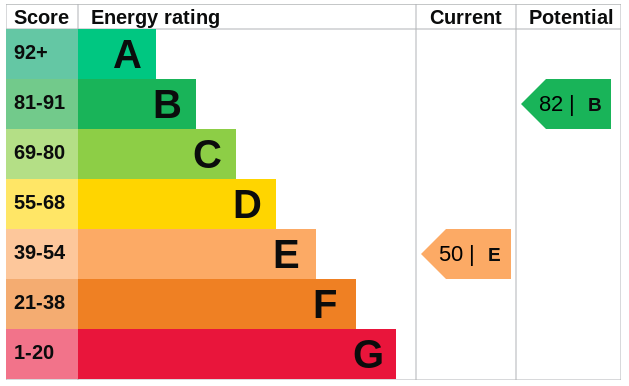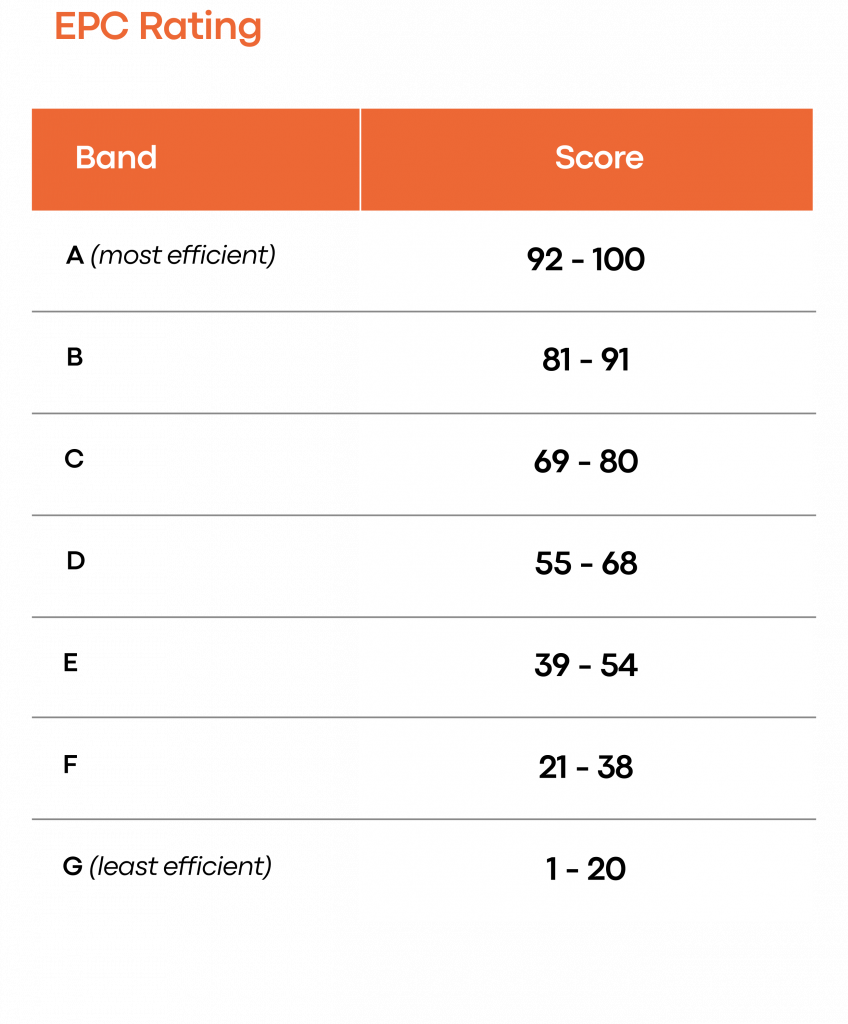 - minute read
- minute read

In the UK, energy performance certificates (EPCs) are a crucial part of buying, selling and renting out properties. These confirm how energy-efficient your property is (or isn’t). In this article, we’ll be looking at what an EPC is, what an EPC comprises of, along with several tips for improving your EPC rating.
Put simply, an energy performance certificate (EPC) rating is a review of a property’s energy efficiency. They’re mainly used by potential home buyers and renters to get an idea of how much energy bills will cost in their new house or flat. Homes with a higher EPC rating will have lower energy bills, whereas homes with lower EPC ratings will have higher energy bills.
In England, Wales and Northern Ireland, EPCs are carried out by EPC assessors (also known as domestic energy assessors). In Scotland, an EPC can only be carried out by a government-approved organisation. EPC assessors conduct a brief survey of your home before producing the EPC. The rating you’re given will depend on the amount of energy used per m² and the level of carbon dioxide emissions.
An EPC will also include recommendations for improving the property’s energy efficiency, along with installation costs and estimated annual savings. You can access a house’s EPC via the EPC register. Once issued, the EPC will be valid for 10 years.

Your energy performance certificate will have two main charts with rating bands. These bands go from A to G, with A being the best rating your property can have, and G being the worst. The numbers within each band reflect the government’s Standard Assessment Procedure (SAP) and go from 1 to 100 SAP points. These scores and their bands can be seen in the table below.
Next, we’ve gone through exactly what you’ll find in an EPC and what it all means.
The above image shows a property’s EPC rating on the energy-efficiency scale, along with the potential rating if all recommendations are followed (there’s more on this later). The higher the rating, the lower your utility bills are likely to be. In this case, following the recommendations would lift this property from Band E to Band B.
The average efficiency rating for a property in England and Wales is Band D (with a rating of 60).
This goes through each feature within a property and assesses it from ‘very good’ to ‘very poor’. This can be used to quickly identify where the problem areas within a property are.
Next up is a list of changes that can be made to improve the property’s energy efficiency. The certificate will state the current rating and the potential rating if these changes are enacted.
Each recommendation includes an estimated installation cost and yearly saving, as well as the rating improvement it’ll have. The number of recommendations depends on the initial energy rating of the property.
This shows the current yearly energy cost for the property (as an estimate) and how much money could be saved if the recommendations are carried out.
An energy performance certificate will also include:
Aside from listed buildings, every house needs to have a valid EPC before it can be sold. When it comes to buying a house, EPC ratings make for an easy comparison between different properties, especially when a potential buyer is looking for a deciding factor to swing them one way or the other. Even if it’s a little more expensive, most people are going to be drawn to the A-rated green property over the G-rated red option.
When your home falls into the latter ‘red’ category, the series of recommendations you’ll be provided with can help improve your EPC rating going forward. Although the minimum rating for rental properties is currently E, the government has proposed new legislation which will take effect in 2025, requiring rental properties to have a minimum C rating (which is why following the advice should be done sooner rather than later).
Essentially, a property with a good EPC rating will be more attractive to potential buyers and tenants alike, as well as making your property more energy-efficient, reducing utility bills in the process.
Buy-to-let landlords are now legally required to have an EPC rating of E or better. Landlords can’t take on new tenants or renew existing contracts for any properties with a lower rating than this.
Getting an EPC is the landlord’s responsibility so doesn’t require any effort on the tenant’s part. Tenants should ask their landlord to send them the relevant EPC before they move in.
Energy performance certificates are legally required for a property before it can be sold. This can either be arranged through an estate agent or with an EPC provider.
People buying a property should receive an EPC from the seller. The recommendations within this certificate can be used to make decisions surrounding any planned renovations. Some buyers even use the EPC to try and negotiate the property price (if the rating is low).
As energy prices skyrocket, now’s an excellent time for landlords to consider ways to improve their Energy Performance Certificate rating. A number of the steps to improve this rating are actually pretty simple. It’s also worth bearing in mind that it usually ends up being cheaper to carry out a property’s worth of changes in one go, rather than making a series of smaller upgrades. With that in mind, here are a handful of ways to improve your property’s EPC.
Insulation is just about the single biggest difference-maker to your EPC rating. The more insulation you get throughout your home – including in the roof, floor, walls and loft – the better your score and the lower your bills will be.
Good loft insulation should be at least 270mm thick. At this thickness, the amount of energy that can escape through the roof will be greatly reduced – an uninsulated roof typically loses up to 33% of heat!
When it comes to wall insulation, the two most popular choices are cavity wall (more aimed at modern properties) and solid wall insulation (typically for older properties). Cavity wall insulation could cost under £500 for a typical semi-detached property while still having a sizeable positive impact on your EPC rating. Sold wall insulation will lead to even bigger bill savings, but can cost between £8,000 and £22,000 for external walls, or £3,500 to £14,500 for internal walls.
While glazing isn’t quite as big a hitter as insulation, getting double glazing installed throughout the property should boost your score by up to ten points. Triple glazing is starting to become more popular as well, further reducing the amount of heat that can escape through windows. However, if you already have double glazing, then the EPC rating improvement from upgrading to triple glazing will be fairly minimal.
Double glazing for a typical terraced property will probably set you back between £2,000 and £5,000.
An old or inefficient boiler will dramatically reduce your EPC score. Switching to a newer, more energy-efficient model can increase your score by as much as 40 points. Pairing this new boiler with smart heating technologies like intelligent thermostats and thermostatic radiator valves can further improve this score, saving you and your tenants on utility costs in the process.
While you’ll have to wait a little bit to recoup the money spent on it, investing in renewable energy for your property is a savvy solution in the long run. The most common example of this is solar panels, which produce cheap, green energy. Another home renewable worth considering is ground-source heat pumps. Both of these will ensure significant EPC rating improvements.
These types of renewables are often incentivised by government-backed funding schemes.
Getting rid of traditional incandescent or halogen bulbs and swapping them out with LEDs should score you a few extra points on your EPC. LEDs are so popular because of the extra efficiency they offer, along with long-term savings on energy bills.
This one doesn’t apply to a large number of homes anyway, but if you have an open fireplace then consider installing a wood-burning stove as an alternative. Wood-burning stoves can provide better fuel efficiency and reduced costs in the long run.
A smart meter is a digital meter which measures your electricity and gas consumption. They regularly send usage data to your service provider, so as to continuously monitor and update your billing. We’d recommend getting a smart meter as they’re a good way of telling your tenants how much energy they’re using so their behaviour can be modified accordingly.
The easiest way to get a new EPC rating is by finding an accredited energy assessor through the government’s EPC register. Estate agents sometimes offer to arrange this for you when selling your home, but this will usually end up being more expensive.
You can find your own or any other property’s energy performance certificate through the EPC register. All you need to do is search by a specific UK postcode, street name or number.
An EPC can cost anywhere from £35 to £120. The exact amount you pay depends on the type of home, how many bedrooms it has and what part of the UK it’s in. Some assessors will charge more than others, so it’s always worth shopping around to try and find the best deal.
The assessment itself will generally take around 45-60 minutes. Again though, this can hugely vary, depending on the size of your home. Once all the necessary checks have been made, you should then get your certificate within a couple of days. This EPC will then be valid for 10 years. When booking an appointment, you can always double-check how long it’ll take them to get the certificate over to you.
Resooma is on a mission to add trust and transparency to the lettings market and can help agents and landlords get more qualified leads and better tenants. Request a callback to learn more about listing with Resooma.



All your utility bills in one monthly payment, split between housemates
Get a quote


All your utility bills in one monthly payment, split between housemates
Get a quoteFinding his article helpful? We’ve got plenty more helpful articles on there way. Join our Savvy Sunday mailing list